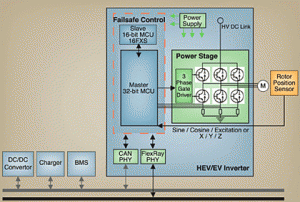MCU Application in HEVs and EVs
The inverter for the electric drive motor is one of the applications of integrated motor control MCUs.
Considering the functional safety, the master motor control MCU is supported by a smaller slave microcontroller. Both of them maintain a constant dialogue if abnormal behavior is detected, the smaller MCU can create a system reset or cut off the power supply to the motor. The master MCU generates the commutation signals for the motor, and monitors the phase currents, as well as generates the resolver signals. It determines the rotor position and angular rate via the sine/cosine feedback. The motor control algorithm uses all this data for targeted control of the rotor speed and torque. The inverter communicates with the battery management system through the internal network (CAN or FlexRay) to ensure that the energy required can also be provided.
Energy efficiency is important in a hybrid electric/electric vehicle (HEV/EV), and any systems which require a constant energy supply, such as hydraulic power steering, would over the long term put excessive strain on the energy storage systems. Hydraulic systems run continuously in order to build up the required pressure by means of a servo pump.
A purely electric power steering (EPS) system only needs energy when in use. In general, the design is similar to that of the inverter for the powertrain. There are master and slave MCUs, while the power element is different mainly in terms of the power to be regulated. A PMSM is used for this application also, while the resolver functions as described. However, the master MCU must still evaluate a steering input device (angle sensor) and a torque sensor. So the correct steering assistance can be given at all times, the EPS control needs data such as the speed of travel, which is provided via the internal network (e.g. the CAN bus). This information helps calculate the extra steering torque required and transmit it to the electric motor on the steering column.
EPS is intended to increase driver comfort and safety, which is entirely possible for an electronic stability control unit to actively regulate vehicle stability by means of steering intervention. It is also conceivable for EPS to be part of a driver assistance system that could park a vehicle automatically without driver input.
While many of them comprise of simple start-stop systems at the moment, the number of full hybrids (HEVs) and plug-in hybrids (PHEVs) is expected to increase substantially in the years to come. And all-electric vehicles that function without an internal combustion engine need safe, cost-effective, and high-capacity energy storage systems. Here, too, technological development is marching ever onward, albeit not quite as quickly as many would prefer. Until then, maximum use must be made of the energy available in the form of fuel and electrical power in hybrid vehicles.

